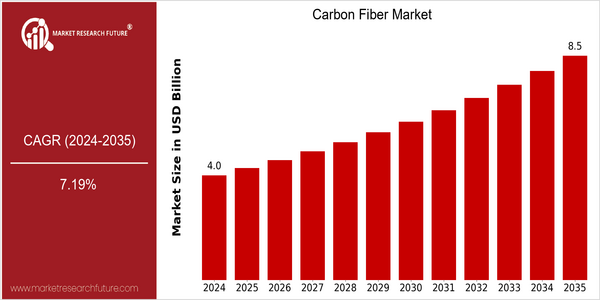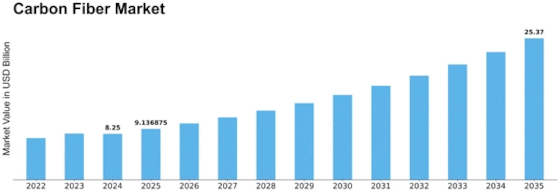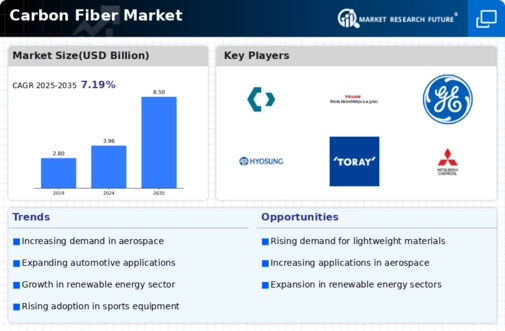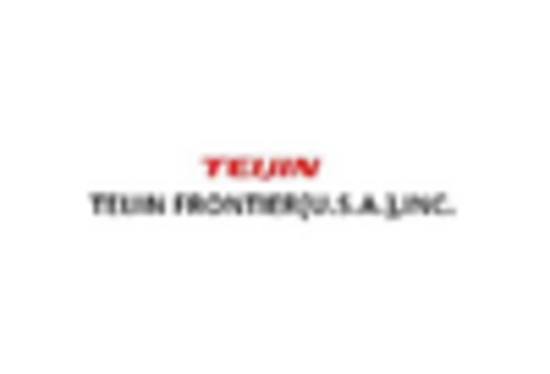-
TABLE OF CONTENTS\r\n \r\n \r\n \r\n1. EXECUTIVE SUMMARY \r\n1.1. Market Overview \r\n1.2. Key Findings \r\n1.3. Market Segmentation \r\n1.4. Competitive Landscape \r\n1.5. Challenges and Opportunities \r\n1.6. Future Outlook \r\n \r\n \r\n2. MARKET INTRODUCTION \r\n2.1. Definition \r\n2.2. Scope of the study \r\n2.2.1. Research Objective \r\n2.2.2. Assumption \r\n2.2.3. Limitations \r\n3. RESEARCH METHODOLOGY \r\n3.1. Overview \r\n3.2. Data Mining \r\n3.3. Secondary Research \r\n3.4. Primary Research \r\n3.4.1. Primary Interviews and Information Gathering Process \r\n3.4.2. Breakdown of Primary Respondents \r\n3.5. Forecasting Model \r\n3.6. Market Size Estimation \r\n3.6.1. Bottom-Up Approach \r\n3.6.2. Top-Down Approach \r\n3.7. Data Triangulation \r\n3.8. Validation \r\n \r\n \r\n \r\n4. MARKET DYNAMICS \r\n4.1. Overview \r\n4.2. Drivers \r\n4.3. Restraints \r\n4.4. Opportunities \r\n5. MARKET FACTOR ANALYSIS \r\n5.1. Value chain Analysis \r\n5.2. Porter's Five Forces Analysis \r\n5.2.1. Bargaining Power of Suppliers \r\n5.2.2. Bargaining Power of Buyers \r\n5.2.3. Threat of New Entrants \r\n5.2.4. Threat of Substitutes \r\n5.2.5. Intensity of Rivalry \r\n5.3. COVID-19 Impact Analysis \r\n5.3.1. Market Impact Analysis \r\n5.3.2. Regional Impact \r\n5.3.3. Opportunity and Threat Analysis \r\n \r\n \r\n \r\n6. CARBON FIBER MARKET, BY APPLICATION (USD BILLION) \r\n6.1. Aerospace \r\n6.2. Automotive \r\n6.3. Wind Energy \r\n6.4. Construction \r\n6.5. Sporting Goods \r\n7. CARBON FIBER MARKET, BY TYPE (USD BILLION) \r\n7.1. Continuous Fiber \r\n7.2. Chopped Fiber \r\n7.3. Fabric \r\n7.4. Prepreg \r\n7.5. Composites \r\n8. CARBON FIBER MARKET, BY END USE INDUSTRY (USD BILLION) \r\n8.1. Aerospace and Defense \r\n8.2. Automotive \r\n8.3. Energy \r\n8.4. Marine \r\n8.5. Civil Engineering \r\n9. CARBON FIBER MARKET, BY MANUFACTURING PROCESS (USD BILLION) \r\n9.1. Pullwinding \r\n9.2. Filament Winding \r\n9.3. Injection Molding \r\n9.4. Layup \r\n9.5. Prepregging \r\n10. CARBON FIBER MARKET, BY REGIONAL (USD BILLION) \r\n10.1. North America \r\n10.1.1. US \r\n10.1.2. Canada \r\n10.2. Europe \r\n10.2.1. Germany \r\n10.2.2. UK \r\n10.2.3. France \r\n10.2.4. Russia \r\n10.2.5. Italy \r\n10.2.6. Spain \r\n10.2.7. Rest of Europe \r\n10.3. APAC \r\n10.3.1. China \r\n10.3.2. India \r\n10.3.3. Japan \r\n10.3.4. South Korea \r\n10.3.5. Malaysia \r\n10.3.6. Thailand \r\n10.3.7. Indonesia \r\n10.3.8. Rest of APAC \r\n10.4. South America \r\n10.4.1. Brazil \r\n10.4.2. Mexico \r\n10.4.3. Argentina \r\n10.4.4. Rest of South America \r\n10.5. MEA \r\n10.5.1. GCC Countries \r\n10.5.2. South Africa \r\n10.5.3. Rest of MEA \r\n \r\n \r\n \r\n11. COMPETITIVE LANDSCAPE \r\n11.1. Overview \r\n11.2. Competitive Analysis \r\n11.3. Market share Analysis \r\n11.4. Major Growth Strategy in the Carbon Fiber Market \r\n11.5. Competitive Benchmarking \r\n11.6. Leading Players in Terms of Number of Developments in the Carbon Fiber Market \r\n11.7. Key developments and growth strategies \r\n11.7.1. New Product Launch/Service Deployment \r\n11.7.2. Merger & Acquisitions \r\n11.7.3. Joint Ventures \r\n11.8. Major Players Financial Matrix \r\n11.8.1. Sales and Operating Income \r\n11.8.2. Major Players R&D Expenditure. 2023 \r\n12. COMPANY PROFILES \r\n12.1. Teijin Limited \r\n12.1.1. Financial Overview \r\n12.1.2. Products Offered \r\n12.1.3. Key Developments \r\n12.1.4. SWOT Analysis \r\n12.1.5. Key Strategies \r\n12.2. K carbon \r\n12.2.1. Financial Overview \r\n12.2.2. Products Offered \r\n12.2.3. Key Developments \r\n12.2.4. SWOT Analysis \r\n12.2.5. Key Strategies \r\n12.3. Hexcel Corporation \r\n12.3.1. Financial Overview \r\n12.3.2. Products Offered \r\n12.3.3. Key Developments \r\n12.3.4. SWOT Analysis \r\n12.3.5. Key Strategies \r\n12.4. Carbon Fiber Technology \r\n12.4.1. Financial Overview \r\n12.4.2. Products Offered \r\n12.4.3. Key Developments \r\n12.4.4. SWOT Analysis \r\n12.4.5. Key Strategies \r\n12.5. Toray Industries \r\n12.5.1. Financial Overview \r\n12.5.2. Products Offered \r\n12.5.3. Key Developments \r\n12.5.4. SWOT Analysis \r\n12.5.5. Key Strategies \r\n12.6. Cytec Solvay Group \r\n12.6.1. Financial Overview \r\n12.6.2. Products Offered \r\n12.6.3. Key Developments \r\n12.6.4. SWOT Analysis \r\n12.6.5. Key Strategies \r\n12.7. Jushi Group \r\n12.7.1. Financial Overview \r\n12.7.2. Products Offered \r\n12.7.3. Key Developments \r\n12.7.4. SWOT Analysis \r\n12.7.5. Key Strategies \r\n12.8. Europe's Carbon Fiber Technology \r\n12.8.1. Financial Overview \r\n12.8.2. Products Offered \r\n12.8.3. Key Developments \r\n12.8.4. SWOT Analysis \r\n12.8.5. Key Strategies \r\n12.9. ZOLTEK Corporation \r\n12.9.1. Financial Overview \r\n12.9.2. Products Offered \r\n12.9.3. Key Developments \r\n12.9.4. SWOT Analysis \r\n12.9.5. Key Strategies \r\n12.10. Anand Group \r\n12.10.1. Financial Overview \r\n12.10.2. Products Offered \r\n12.10.3. Key Developments \r\n12.10.4. SWOT Analysis \r\n12.10.5. Key Strategies \r\n12.11. Formosa Plastics Corporation \r\n12.11.1. Financial Overview \r\n12.11.2. Products Offered \r\n12.11.3. Key Developments \r\n12.11.4. SWOT Analysis \r\n12.11.5. Key Strategies \r\n12.12. Gurit Holding AG \r\n12.12.1. Financial Overview \r\n12.12.2. Products Offered \r\n12.12.3. Key Developments \r\n12.12.4. SWOT Analysis \r\n12.12.5. Key Strategies \r\n12.13. BASF SE \r\n12.13.1. Financial Overview \r\n12.13.2. Products Offered \r\n12.13.3. Key Developments \r\n12.13.4. SWOT Analysis \r\n12.13.5. Key Strategies \r\n12.14. Mitsubishi Chemical Holdings \r\n12.14.1. Financial Overview \r\n12.14.2. Products Offered \r\n12.14.3. Key Developments \r\n12.14.4. SWOT Analysis \r\n12.14.5. Key Strategies \r\n12.15. SGL Carbon \r\n12.15.1. Financial Overview \r\n12.15.2. Products Offered \r\n12.15.3. Key Developments \r\n12.15.4. SWOT Analysis \r\n12.15.5. Key Strategies \r\n13.
-
APPENDIX \r\n13.1.
-
References \r\n13.2. Related Reports \r\nLIST OF TABLES\r\n \r\nTABLE
-
LIST OF ASSUMPTIONS \r\nTABLE
-
NORTH AMERICA CARBON FIBER MARKET SIZE ESTIMATES & FORECAST, BY APPLICATION, 2019-2035 (USD BILLIONS) \r\nTABLE
-
NORTH AMERICA CARBON FIBER MARKET SIZE ESTIMATES & FORECAST, BY TYPE, 2019-2035 (USD BILLIONS) \r\nTABLE
-
NORTH AMERICA CARBON FIBER MARKET SIZE ESTIMATES & FORECAST, BY END USE INDUSTRY, 2019-2035 (USD BILLIONS) \r\nTABLE
-
NORTH AMERICA CARBON FIBER MARKET SIZE ESTIMATES & FORECAST, BY MANUFACTURING PROCESS, 2019-2035 (USD BILLIONS) \r\nTABLE
-
NORTH AMERICA CARBON FIBER MARKET SIZE ESTIMATES & FORECAST, BY REGIONAL, 2019-2035 (USD BILLIONS) \r\nTABLE
-
US CARBON FIBER MARKET SIZE ESTIMATES & FORECAST, BY APPLICATION, 2019-2035 (USD BILLIONS) \r\nTABLE
-
US CARBON FIBER MARKET SIZE ESTIMATES & FORECAST, BY TYPE, 2019-2035 (USD BILLIONS) \r\nTABLE
-
US CARBON FIBER MARKET SIZE ESTIMATES & FORECAST, BY END USE INDUSTRY, 2019-2035 (USD BILLIONS) \r\nTABLE
-
US CARBON FIBER MARKET SIZE ESTIMATES & FORECAST, BY MANUFACTURING PROCESS, 2019-2035 (USD BILLIONS) \r\nTABLE
-
US CARBON FIBER MARKET SIZE ESTIMATES & FORECAST, BY REGIONAL, 2019-2035 (USD BILLIONS) \r\nTABLE
-
CANADA CARBON FIBER MARKET SIZE ESTIMATES & FORECAST, BY APPLICATION, 2019-2035 (USD BILLIONS) \r\nTABLE
-
CANADA CARBON FIBER MARKET SIZE ESTIMATES & FORECAST, BY TYPE, 2019-2035 (USD BILLIONS) \r\nTABLE
-
CANADA CARBON FIBER MARKET SIZE ESTIMATES & FORECAST, BY END USE INDUSTRY, 2019-2035 (USD BILLIONS) \r\nTABLE
-
CANADA CARBON FIBER MARKET SIZE ESTIMATES & FORECAST, BY MANUFACTURING PROCESS, 2019-2035 (USD BILLIONS) \r\nTABLE
-
CANADA CARBON FIBER MARKET SIZE ESTIMATES & FORECAST, BY REGIONAL, 2019-2035 (USD BILLIONS) \r\nTABLE
-
EUROPE CARBON FIBER MARKET SIZE ESTIMATES & FORECAST, BY APPLICATION, 2019-2035 (USD BILLIONS) \r\nTABLE
-
EUROPE CARBON FIBER MARKET SIZE ESTIMATES & FORECAST, BY TYPE, 2019-2035 (USD BILLIONS) \r\nTABLE
-
EUROPE CARBON FIBER MARKET SIZE ESTIMATES & FORECAST, BY END USE INDUSTRY, 2019-2035 (USD BILLIONS) \r\nTABLE
-
EUROPE CARBON FIBER MARKET SIZE ESTIMATES & FORECAST, BY MANUFACTURING PROCESS, 2019-2035 (USD BILLIONS) \r\nTABLE
-
EUROPE CARBON FIBER MARKET SIZE ESTIMATES & FORECAST, BY REGIONAL, 2019-2035 (USD BILLIONS) \r\nTABLE
-
GERMANY CARBON FIBER MARKET SIZE ESTIMATES & FORECAST, BY APPLICATION, 2019-2035 (USD BILLIONS) \r\nTABLE
-
GERMANY CARBON FIBER MARKET SIZE ESTIMATES & FORECAST, BY TYPE, 2019-2035 (USD BILLIONS) \r\nTABLE
-
GERMANY CARBON FIBER MARKET SIZE ESTIMATES & FORECAST, BY END USE INDUSTRY, 2019-2035 (USD BILLIONS) \r\nTABLE
-
GERMANY CARBON FIBER MARKET SIZE ESTIMATES & FORECAST, BY MANUFACTURING PROCESS, 2019-2035 (USD BILLIONS) \r\nTABLE
-
GERMANY CARBON FIBER MARKET SIZE ESTIMATES & FORECAST, BY REGIONAL, 2019-2035 (USD BILLIONS) \r\nTABLE
-
UK CARBON FIBER MARKET SIZE ESTIMATES & FORECAST, BY APPLICATION, 2019-2035 (USD BILLIONS) \r\nTABLE
-
UK CARBON FIBER MARKET SIZE ESTIMATES & FORECAST, BY TYPE, 2019-2035 (USD BILLIONS) \r\nTABLE
-
UK CARBON FIBER MARKET SIZE ESTIMATES & FORECAST, BY END USE INDUSTRY, 2019-2035 (USD BILLIONS) \r\nTABLE
-
UK CARBON FIBER MARKET SIZE ESTIMATES & FORECAST, BY MANUFACTURING PROCESS, 2019-2035 (USD BILLIONS) \r\nTABLE
-
UK CARBON FIBER MARKET SIZE ESTIMATES & FORECAST, BY REGIONAL, 2019-2035 (USD BILLIONS) \r\nTABLE
-
FRANCE CARBON FIBER MARKET SIZE ESTIMATES & FORECAST, BY APPLICATION, 2019-2035 (USD BILLIONS) \r\nTABLE
-
FRANCE CARBON FIBER MARKET SIZE ESTIMATES & FORECAST, BY TYPE, 2019-2035 (USD BILLIONS) \r\nTABLE
-
FRANCE CARBON FIBER MARKET SIZE ESTIMATES & FORECAST, BY END USE INDUSTRY, 2019-2035 (USD BILLIONS) \r\nTABLE
-
FRANCE CARBON FIBER MARKET SIZE ESTIMATES & FORECAST, BY MANUFACTURING PROCESS, 2019-2035 (USD BILLIONS) \r\nTABLE
-
FRANCE CARBON FIBER MARKET SIZE ESTIMATES & FORECAST, BY REGIONAL, 2019-2035 (USD BILLIONS) \r\nTABLE
-
RUSSIA CARBON FIBER MARKET SIZE ESTIMATES & FORECAST, BY APPLICATION, 2019-2035 (USD BILLIONS) \r\nTABLE
-
RUSSIA CARBON FIBER MARKET SIZE ESTIMATES & FORECAST, BY TYPE, 2019-2035 (USD BILLIONS) \r\nTABLE
-
RUSSIA CARBON FIBER MARKET SIZE ESTIMATES & FORECAST, BY END USE INDUSTRY, 2019-2035 (USD BILLIONS) \r\nTABLE
-
RUSSIA CARBON FIBER MARKET SIZE ESTIMATES & FORECAST, BY MANUFACTURING PROCESS, 2019-2035 (USD BILLIONS) \r\nTABLE
-
RUSSIA CARBON FIBER MARKET SIZE ESTIMATES & FORECAST, BY REGIONAL, 2019-2035 (USD BILLIONS) \r\nTABLE
-
ITALY CARBON FIBER MARKET SIZE ESTIMATES & FORECAST, BY APPLICATION, 2019-2035 (USD BILLIONS) \r\nTABLE
-
ITALY CARBON FIBER MARKET SIZE ESTIMATES & FORECAST, BY TYPE, 2019-2035 (USD BILLIONS) \r\nTABLE
-
ITALY CARBON FIBER MARKET SIZE ESTIMATES & FORECAST, BY END USE INDUSTRY, 2019-2035 (USD BILLIONS) \r\nTABLE
-
ITALY CARBON FIBER MARKET SIZE ESTIMATES & FORECAST, BY MANUFACTURING PROCESS, 2019-2035 (USD BILLIONS) \r\nTABLE
-
ITALY CARBON FIBER MARKET SIZE ESTIMATES & FORECAST, BY REGIONAL, 2019-2035 (USD BILLIONS) \r\nTABLE
-
SPAIN CARBON FIBER MARKET SIZE ESTIMATES & FORECAST, BY APPLICATION, 2019-2035 (USD BILLIONS) \r\nTABLE
-
SPAIN CARBON FIBER MARKET SIZE ESTIMATES & FORECAST, BY TYPE, 2019-2035 (USD BILLIONS) \r\nTABLE
-
SPAIN CARBON FIBER MARKET SIZE ESTIMATES & FORECAST, BY END USE INDUSTRY, 2019-2035 (USD BILLIONS) \r\nTABLE
-
SPAIN CARBON FIBER MARKET SIZE ESTIMATES & FORECAST, BY MANUFACTURING PROCESS, 2019-2035 (USD BILLIONS) \r\nTABLE
-
SPAIN CARBON FIBER MARKET SIZE ESTIMATES & FORECAST, BY REGIONAL, 2019-2035 (USD BILLIONS) \r\nTABLE
-
REST OF EUROPE CARBON FIBER MARKET SIZE ESTIMATES & FORECAST, BY APPLICATION, 2019-2035 (USD BILLIONS) \r\nTABLE
-
REST OF EUROPE CARBON FIBER MARKET SIZE ESTIMATES & FORECAST, BY TYPE, 2019-2035 (USD BILLIONS) \r\nTABLE
-
REST OF EUROPE CARBON FIBER MARKET SIZE ESTIMATES & FORECAST, BY END USE INDUSTRY, 2019-2035 (USD BILLIONS) \r\nTABLE
-
REST OF EUROPE CARBON FIBER MARKET SIZE ESTIMATES & FORECAST, BY MANUFACTURING PROCESS, 2019-2035 (USD BILLIONS) \r\nTABLE
-
REST OF EUROPE CARBON FIBER MARKET SIZE ESTIMATES & FORECAST, BY REGIONAL, 2019-2035 (USD BILLIONS) \r\nTABLE
-
APAC CARBON FIBER MARKET SIZE ESTIMATES & FORECAST, BY APPLICATION, 2019-2035 (USD BILLIONS) \r\nTABLE
-
APAC CARBON FIBER MARKET SIZE ESTIMATES & FORECAST, BY TYPE, 2019-2035 (USD BILLIONS) \r\nTABLE
-
APAC CARBON FIBER MARKET SIZE ESTIMATES & FORECAST, BY END USE INDUSTRY, 2019-2035 (USD BILLIONS) \r\nTABLE
-
APAC CARBON FIBER MARKET SIZE ESTIMATES & FORECAST, BY MANUFACTURING PROCESS, 2019-2035 (USD BILLIONS) \r\nTABLE
-
APAC CARBON FIBER MARKET SIZE ESTIMATES & FORECAST, BY REGIONAL, 2019-2035 (USD BILLIONS) \r\nTABLE
-
CHINA CARBON FIBER MARKET SIZE ESTIMATES & FORECAST, BY APPLICATION, 2019-2035 (USD BILLIONS) \r\nTABLE
-
CHINA CARBON FIBER MARKET SIZE ESTIMATES & FORECAST, BY TYPE, 2019-2035 (USD BILLIONS) \r\nTABLE
-
CHINA CARBON FIBER MARKET SIZE ESTIMATES & FORECAST, BY END USE INDUSTRY, 2019-2035 (USD BILLIONS) \r\nTABLE
-
CHINA CARBON FIBER MARKET SIZE ESTIMATES & FORECAST, BY MANUFACTURING PROCESS, 2019-2035 (USD BILLIONS) \r\nTABLE
-
CHINA CARBON FIBER MARKET SIZE ESTIMATES & FORECAST, BY REGIONAL, 2019-2035 (USD BILLIONS) \r\nTABLE
-
INDIA CARBON FIBER MARKET SIZE ESTIMATES & FORECAST, BY APPLICATION, 2019-2035 (USD BILLIONS) \r\nTABLE
-
INDIA CARBON FIBER MARKET SIZE ESTIMATES & FORECAST, BY TYPE, 2019-2035 (USD BILLIONS) \r\nTABLE
-
INDIA CARBON FIBER MARKET SIZE ESTIMATES & FORECAST, BY END USE INDUSTRY, 2019-2035 (USD BILLIONS) \r\nTABLE
-
INDIA CARBON FIBER MARKET SIZE ESTIMATES & FORECAST, BY MANUFACTURING PROCESS, 2019-2035 (USD BILLIONS) \r\nTABLE
-
INDIA CARBON FIBER MARKET SIZE ESTIMATES & FORECAST, BY REGIONAL, 2019-2035 (USD BILLIONS) \r\nTABLE
-
JAPAN CARBON FIBER MARKET SIZE ESTIMATES & FORECAST, BY APPLICATION, 2019-2035 (USD BILLIONS) \r\nTABLE
-
JAPAN CARBON FIBER MARKET SIZE ESTIMATES & FORECAST, BY TYPE, 2019-2035 (USD BILLIONS) \r\nTABLE
-
JAPAN CARBON FIBER MARKET SIZE ESTIMATES & FORECAST, BY END USE INDUSTRY, 2019-2035 (USD BILLIONS) \r\nTABLE
-
JAPAN CARBON FIBER MARKET SIZE ESTIMATES & FORECAST, BY MANUFACTURING PROCESS, 2019-2035 (USD BILLIONS) \r\nTABLE
-
JAPAN CARBON FIBER MARKET SIZE ESTIMATES & FORECAST, BY REGIONAL, 2019-2035 (USD BILLIONS) \r\nTABLE
-
SOUTH KOREA CARBON FIBER MARKET SIZE ESTIMATES & FORECAST, BY APPLICATION, 2019-2035 (USD BILLIONS) \r\nTABLE
-
SOUTH KOREA CARBON FIBER MARKET SIZE ESTIMATES & FORECAST, BY TYPE, 2019-2035 (USD BILLIONS) \r\nTABLE
-
SOUTH KOREA CARBON FIBER MARKET SIZE ESTIMATES & FORECAST, BY END USE INDUSTRY, 2019-2035 (USD BILLIONS) \r\nTABLE
-
SOUTH KOREA CARBON FIBER MARKET SIZE ESTIMATES & FORECAST, BY MANUFACTURING PROCESS, 2019-2035 (USD BILLIONS) \r\nTABLE
-
SOUTH KOREA CARBON FIBER MARKET SIZE ESTIMATES & FORECAST, BY REGIONAL, 2019-2035 (USD BILLIONS) \r\nTABLE
-
MALAYSIA CARBON FIBER MARKET SIZE ESTIMATES & FORECAST, BY APPLICATION, 2019-2035 (USD BILLIONS) \r\nTABLE
-
MALAYSIA CARBON FIBER MARKET SIZE ESTIMATES & FORECAST, BY TYPE, 2019-2035 (USD BILLIONS) \r\nTABLE
-
MALAYSIA CARBON FIBER MARKET SIZE ESTIMATES & FORECAST, BY END USE INDUSTRY, 2019-2035 (USD BILLIONS) \r\nTABLE
-
MALAYSIA CARBON FIBER MARKET SIZE ESTIMATES & FORECAST, BY MANUFACTURING PROCESS, 2019-2035 (USD BILLIONS) \r\nTABLE
-
MALAYSIA CARBON FIBER MARKET SIZE ESTIMATES & FORECAST, BY REGIONAL, 2019-2035 (USD BILLIONS) \r\nTABLE
-
THAILAND CARBON FIBER MARKET SIZE ESTIMATES & FORECAST, BY APPLICATION, 2019-2035 (USD BILLIONS) \r\nTABLE
-
THAILAND CARBON FIBER MARKET SIZE ESTIMATES & FORECAST, BY TYPE, 2019-2035 (USD BILLIONS) \r\nTABLE
-
THAILAND CARBON FIBER MARKET SIZE ESTIMATES & FORECAST, BY END USE INDUSTRY, 2019-2035 (USD BILLIONS) \r\nTABLE
-
THAILAND CARBON FIBER MARKET SIZE ESTIMATES & FORECAST, BY MANUFACTURING PROCESS, 2019-2035 (USD BILLIONS) \r\nTABLE
-
THAILAND CARBON FIBER MARKET SIZE ESTIMATES & FORECAST, BY REGIONAL, 2019-2035 (USD BILLIONS) \r\nTABLE
-
INDONESIA CARBON FIBER MARKET SIZE ESTIMATES & FORECAST, BY APPLICATION, 2019-2035 (USD BILLIONS) \r\nTABLE
-
INDONESIA CARBON FIBER MARKET SIZE ESTIMATES & FORECAST, BY TYPE, 2019-2035 (USD BILLIONS) \r\nTABLE
-
INDONESIA CARBON FIBER MARKET SIZE ESTIMATES & FORECAST, BY END USE INDUSTRY, 2019-2035 (USD BILLIONS) \r\nTABLE
-
INDONESIA CARBON FIBER MARKET SIZE ESTIMATES & FORECAST, BY MANUFACTURING PROCESS, 2019-2035 (USD BILLIONS) \r\nTABLE
-
INDONESIA CARBON FIBER MARKET SIZE ESTIMATES & FORECAST, BY REGIONAL, 2019-2035 (USD BILLIONS) \r\nTABLE
-
REST OF APAC CARBON FIBER MARKET SIZE ESTIMATES & FORECAST, BY APPLICATION, 2019-2035 (USD BILLIONS) \r\nTABLE
-
REST OF APAC CARBON FIBER MARKET SIZE ESTIMATES & FORECAST, BY TYPE, 2019-2035 (USD BILLIONS) \r\nTABLE
-
REST OF APAC CARBON FIBER MARKET SIZE ESTIMATES & FORECAST, BY END USE INDUSTRY, 2019-2035 (USD BILLIONS) \r\nTABLE
-
REST OF APAC CARBON FIBER MARKET SIZE ESTIMATES & FORECAST, BY MANUFACTURING PROCESS, 2019-2035 (USD BILLIONS) \r\nTABLE
-
REST OF APAC CARBON FIBER MARKET SIZE ESTIMATES & FORECAST, BY REGIONAL, 2019-2035 (USD BILLIONS) \r\nTABLE
-
SOUTH AMERICA CARBON FIBER MARKET SIZE ESTIMATES & FORECAST, BY APPLICATION, 2019-2035 (USD BILLIONS) \r\nTABLE
-
SOUTH AMERICA CARBON FIBER MARKET SIZE ESTIMATES & FORECAST, BY TYPE, 2019-2035 (USD BILLIONS) \r\nTABLE
-
SOUTH AMERICA CARBON FIBER MARKET SIZE ESTIMATES & FORECAST, BY END USE INDUSTRY, 2019-2035 (USD BILLIONS) \r\nTABLE
-
SOUTH AMERICA CARBON FIBER MARKET SIZE ESTIMATES & FORECAST, BY MANUFACTURING PROCESS, 2019-2035 (USD BILLIONS) \r\nTABLE
-
SOUTH AMERICA CARBON FIBER MARKET SIZE ESTIMATES & FORECAST, BY REGIONAL, 2019-2035 (USD BILLIONS) \r\nTABLE
-
BRAZIL CARBON FIBER MARKET SIZE ESTIMATES & FORECAST, BY APPLICATION, 2019-2035 (USD BILLIONS) \r\nTABLE
-
BRAZIL CARBON FIBER MARKET SIZE ESTIMATES & FORECAST, BY TYPE, 2019-2035 (USD BILLIONS) \r\nTABLE
-
BRAZIL CARBON FIBER MARKET SIZE ESTIMATES & FORECAST, BY END USE INDUSTRY, 2019-2035 (USD BILLIONS) \r\nTABLE
-
BRAZIL CARBON FIBER MARKET SIZE ESTIMATES & FORECAST, BY MANUFACTURING PROCESS, 2019-2035 (USD BILLIONS) \r\nTABLE
-
BRAZIL CARBON FIBER MARKET SIZE ESTIMATES & FORECAST, BY REGIONAL, 2019-2035 (USD BILLIONS) \r\nTABLE
-
MEXICO CARBON FIBER MARKET SIZE ESTIMATES & FORECAST, BY APPLICATION, 2019-2035 (USD BILLIONS) \r\nTABLE
-
MEXICO CARBON FIBER MARKET SIZE ESTIMATES & FORECAST, BY TYPE, 2019-2035 (USD BILLIONS) \r\nTABLE
-
MEXICO CARBON FIBER MARKET SIZE ESTIMATES & FORECAST, BY END USE INDUSTRY, 2019-2035 (USD BILLIONS) \r\nTABLE
-
MEXICO CARBON FIBER MARKET SIZE ESTIMATES & FORECAST, BY MANUFACTURING PROCESS, 2019-2035 (USD BILLIONS) \r\nTABLE
-
MEXICO CARBON FIBER MARKET SIZE ESTIMATES & FORECAST, BY REGIONAL, 2019-2035 (USD BILLIONS) \r\nTABLE
-
ARGENTINA CARBON FIBER MARKET SIZE ESTIMATES & FORECAST, BY APPLICATION, 2019-2035 (USD BILLIONS) \r\nTABLE
-
ARGENTINA CARBON FIBER MARKET SIZE ESTIMATES & FORECAST, BY TYPE, 2019-2035 (USD BILLIONS) \r\nTABLE
-
ARGENTINA CARBON FIBER MARKET SIZE ESTIMATES & FORECAST, BY END USE INDUSTRY, 2019-2035 (USD BILLIONS) \r\nTABLE
-
ARGENTINA CARBON FIBER MARKET SIZE ESTIMATES & FORECAST, BY MANUFACTURING PROCESS, 2019-2035 (USD BILLIONS) \r\nTABLE
-
ARGENTINA CARBON FIBER MARKET SIZE ESTIMATES & FORECAST, BY REGIONAL, 2019-2035 (USD BILLIONS) \r\nTABLE
-
REST OF SOUTH AMERICA CARBON FIBER MARKET SIZE ESTIMATES & FORECAST, BY APPLICATION, 2019-2035 (USD BILLIONS) \r\nTABLE
-
REST OF SOUTH AMERICA CARBON FIBER MARKET SIZE ESTIMATES & FORECAST, BY TYPE, 2019-2035 (USD BILLIONS) \r\nTABLE
-
REST OF SOUTH AMERICA CARBON FIBER MARKET SIZE ESTIMATES & FORECAST, BY END USE INDUSTRY, 2019-2035 (USD BILLIONS) \r\nTABLE
-
REST OF SOUTH AMERICA CARBON FIBER MARKET SIZE ESTIMATES & FORECAST, BY MANUFACTURING PROCESS, 2019-2035 (USD BILLIONS) \r\nTABLE
-
REST OF SOUTH AMERICA CARBON FIBER MARKET SIZE ESTIMATES & FORECAST, BY REGIONAL, 2019-2035 (USD BILLIONS) \r\nTABLE
-
MEA CARBON FIBER MARKET SIZE ESTIMATES & FORECAST, BY APPLICATION, 2019-2035 (USD BILLIONS) \r\nTABLE
-
MEA CARBON FIBER MARKET SIZE ESTIMATES & FORECAST, BY TYPE, 2019-2035 (USD BILLIONS) \r\nTABLE
-
MEA CARBON FIBER MARKET SIZE ESTIMATES & FORECAST, BY END USE INDUSTRY, 2019-2035 (USD BILLIONS) \r\nTABLE
-
MEA CARBON FIBER MARKET SIZE ESTIMATES & FORECAST, BY MANUFACTURING PROCESS, 2019-2035 (USD BILLIONS) \r\nTABLE
-
MEA CARBON FIBER MARKET SIZE ESTIMATES & FORECAST, BY REGIONAL, 2019-2035 (USD BILLIONS) \r\nTABLE
-
GCC COUNTRIES CARBON FIBER MARKET SIZE ESTIMATES & FORECAST, BY APPLICATION, 2019-2035 (USD BILLIONS) \r\nTABLE
-
GCC COUNTRIES CARBON FIBER MARKET SIZE ESTIMATES & FORECAST, BY TYPE, 2019-2035 (USD BILLIONS) \r\nTABLE
-
GCC COUNTRIES CARBON FIBER MARKET SIZE ESTIMATES & FORECAST, BY END USE INDUSTRY, 2019-2035 (USD BILLIONS) \r\nTABLE
-
GCC COUNTRIES CARBON FIBER MARKET SIZE ESTIMATES & FORECAST, BY MANUFACTURING PROCESS, 2019-2035 (USD BILLIONS) \r\nTABLE
-
GCC COUNTRIES CARBON FIBER MARKET SIZE ESTIMATES & FORECAST, BY REGIONAL, 2019-2035 (USD BILLIONS) \r\nTABLE
-
SOUTH AFRICA CARBON FIBER MARKET SIZE ESTIMATES & FORECAST, BY APPLICATION, 2019-2035 (USD BILLIONS) \r\nTABLE
-
SOUTH AFRICA CARBON FIBER MARKET SIZE ESTIMATES & FORECAST, BY TYPE, 2019-2035 (USD BILLIONS) \r\nTABLE
-
SOUTH AFRICA CARBON FIBER MARKET SIZE ESTIMATES & FORECAST, BY END USE INDUSTRY, 2019-2035 (USD BILLIONS) \r\nTABLE
-
SOUTH AFRICA CARBON FIBER MARKET SIZE ESTIMATES & FORECAST, BY MANUFACTURING PROCESS, 2019-2035 (USD BILLIONS) \r\nTABLE
-
SOUTH AFRICA CARBON FIBER MARKET SIZE ESTIMATES & FORECAST, BY REGIONAL, 2019-2035 (USD BILLIONS) \r\nTABLE
-
REST OF MEA CARBON FIBER MARKET SIZE ESTIMATES & FORECAST, BY APPLICATION, 2019-2035 (USD BILLIONS) \r\nTABLE
-
REST OF MEA CARBON FIBER MARKET SIZE ESTIMATES & FORECAST, BY TYPE, 2019-2035 (USD BILLIONS) \r\nTABLE
-
REST OF MEA CARBON FIBER MARKET SIZE ESTIMATES & FORECAST, BY END USE INDUSTRY, 2019-2035 (USD BILLIONS) \r\nTABLE
-
REST OF MEA CARBON FIBER MARKET SIZE ESTIMATES & FORECAST, BY MANUFACTURING PROCESS, 2019-2035 (USD BILLIONS) \r\nTABLE
-
REST OF MEA CARBON FIBER MARKET SIZE ESTIMATES & FORECAST, BY REGIONAL, 2019-2035 (USD BILLIONS) \r\nTABLE
-
PRODUCT LAUNCH/PRODUCT DEVELOPMENT/APPROVAL \r\nTABLE
-
ACQUISITION/PARTNERSHIP \r\n \r\n \r\n \r\n \r\n \r\nLIST OF FIGURES\r\n \r\nFIGURE
-
MARKET SYNOPSIS \r\nFIGURE
-
NORTH AMERICA CARBON FIBER MARKET ANALYSIS \r\nFIGURE
-
US CARBON FIBER MARKET ANALYSIS BY APPLICATION \r\nFIGURE
-
US CARBON FIBER MARKET ANALYSIS BY TYPE \r\nFIGURE
-
US CARBON FIBER MARKET ANALYSIS BY END USE INDUSTRY \r\nFIGURE
-
US CARBON FIBER MARKET ANALYSIS BY MANUFACTURING PROCESS \r\nFIGURE
-
US CARBON FIBER MARKET ANALYSIS BY REGIONAL \r\nFIGURE
-
CANADA CARBON FIBER MARKET ANALYSIS BY APPLICATION \r\nFIGURE
-
CANADA CARBON FIBER MARKET ANALYSIS BY TYPE \r\nFIGURE
-
CANADA CARBON FIBER MARKET ANALYSIS BY END USE INDUSTRY \r\nFIGURE
-
CANADA CARBON FIBER MARKET ANALYSIS BY MANUFACTURING PROCESS \r\nFIGURE
-
CANADA CARBON FIBER MARKET ANALYSIS BY REGIONAL \r\nFIGURE
-
EUROPE CARBON FIBER MARKET ANALYSIS \r\nFIGURE
-
GERMANY CARBON FIBER MARKET ANALYSIS BY APPLICATION \r\nFIGURE
-
GERMANY CARBON FIBER MARKET ANALYSIS BY TYPE \r\nFIGURE
-
GERMANY CARBON FIBER MARKET ANALYSIS BY END USE INDUSTRY \r\nFIGURE
-
GERMANY CARBON FIBER MARKET ANALYSIS BY MANUFACTURING PROCESS \r\nFIGURE
-
GERMANY CARBON FIBER MARKET ANALYSIS BY REGIONAL \r\nFIGURE
-
UK CARBON FIBER MARKET ANALYSIS BY APPLICATION \r\nFIGURE
-
UK CARBON FIBER MARKET ANALYSIS BY TYPE \r\nFIGURE
-
UK CARBON FIBER MARKET ANALYSIS BY END USE INDUSTRY \r\nFIGURE
-
UK CARBON FIBER MARKET ANALYSIS BY MANUFACTURING PROCESS \r\nFIGURE
-
UK CARBON FIBER MARKET ANALYSIS BY REGIONAL \r\nFIGURE
-
FRANCE CARBON FIBER MARKET ANALYSIS BY APPLICATION \r\nFIGURE
-
FRANCE CARBON FIBER MARKET ANALYSIS BY TYPE \r\nFIGURE
-
FRANCE CARBON FIBER MARKET ANALYSIS BY END USE INDUSTRY \r\nFIGURE
-
FRANCE CARBON FIBER MARKET ANALYSIS BY MANUFACTURING PROCESS \r\nFIGURE
-
FRANCE CARBON FIBER MARKET ANALYSIS BY REGIONAL \r\nFIGURE
-
RUSSIA CARBON FIBER MARKET ANALYSIS BY APPLICATION \r\nFIGURE
-
RUSSIA CARBON FIBER MARKET ANALYSIS BY TYPE \r\nFIGURE
-
RUSSIA CARBON FIBER MARKET ANALYSIS BY END USE INDUSTRY \r\nFIGURE
-
RUSSIA CARBON FIBER MARKET ANALYSIS BY MANUFACTURING PROCESS \r\nFIGURE
-
RUSSIA CARBON FIBER MARKET ANALYSIS BY REGIONAL \r\nFIGURE
-
ITALY CARBON FIBER MARKET ANALYSIS BY APPLICATION \r\nFIGURE
-
ITALY CARBON FIBER MARKET ANALYSIS BY TYPE \r\nFIGURE
-
ITALY CARBON FIBER MARKET ANALYSIS BY END USE INDUSTRY \r\nFIGURE
-
ITALY CARBON FIBER MARKET ANALYSIS BY MANUFACTURING PROCESS \r\nFIGURE
-
ITALY CARBON FIBER MARKET ANALYSIS BY REGIONAL \r\nFIGURE
-
SPAIN CARBON FIBER MARKET ANALYSIS BY APPLICATION \r\nFIGURE
-
SPAIN CARBON FIBER MARKET ANALYSIS BY TYPE \r\nFIGURE
-
SPAIN CARBON FIBER MARKET ANALYSIS BY END USE INDUSTRY \r\nFIGURE
-
SPAIN CARBON FIBER MARKET ANALYSIS BY MANUFACTURING PROCESS \r\nFIGURE
-
SPAIN CARBON FIBER MARKET ANALYSIS BY REGIONAL \r\nFIGURE
-
REST OF EUROPE CARBON FIBER MARKET ANALYSIS BY APPLICATION \r\nFIGURE
-
REST OF EUROPE CARBON FIBER MARKET ANALYSIS BY TYPE \r\nFIGURE
-
REST OF EUROPE CARBON FIBER MARKET ANALYSIS BY END USE INDUSTRY \r\nFIGURE
-
REST OF EUROPE CARBON FIBER MARKET ANALYSIS BY MANUFACTURING PROCESS \r\nFIGURE
-
REST OF EUROPE CARBON FIBER MARKET ANALYSIS BY REGIONAL \r\nFIGURE
-
APAC CARBON FIBER MARKET ANALYSIS \r\nFIGURE
-
CHINA CARBON FIBER MARKET ANALYSIS BY APPLICATION \r\nFIGURE
-
CHINA CARBON FIBER MARKET ANALYSIS BY TYPE \r\nFIGURE
-
CHINA CARBON FIBER MARKET ANALYSIS BY END USE INDUSTRY \r\nFIGURE
-
CHINA CARBON FIBER MARKET ANALYSIS BY MANUFACTURING PROCESS \r\nFIGURE
-
CHINA CARBON FIBER MARKET ANALYSIS BY REGIONAL \r\nFIGURE
-
INDIA CARBON FIBER MARKET ANALYSIS BY APPLICATION \r\nFIGURE
-
INDIA CARBON FIBER MARKET ANALYSIS BY TYPE \r\nFIGURE
-
INDIA CARBON FIBER MARKET ANALYSIS BY END USE INDUSTRY \r\nFIGURE
-
INDIA CARBON FIBER MARKET ANALYSIS BY MANUFACTURING PROCESS \r\nFIGURE
-
INDIA CARBON FIBER MARKET ANALYSIS BY REGIONAL \r\nFIGURE
-
JAPAN CARBON FIBER MARKET ANALYSIS BY APPLICATION \r\nFIGURE
-
JAPAN CARBON FIBER MARKET ANALYSIS BY TYPE \r\nFIGURE
-
JAPAN CARBON FIBER MARKET ANALYSIS BY END USE INDUSTRY \r\nFIGURE
-
JAPAN CARBON FIBER MARKET ANALYSIS BY MANUFACTURING PROCESS \r\nFIGURE
-
JAPAN CARBON FIBER MARKET ANALYSIS BY REGIONAL \r\nFIGURE
-
SOUTH KOREA CARBON FIBER MARKET ANALYSIS BY APPLICATION \r\nFIGURE
-
SOUTH KOREA CARBON FIBER MARKET ANALYSIS BY TYPE \r\nFIGURE
-
SOUTH KOREA CARBON FIBER MARKET ANALYSIS BY END USE INDUSTRY \r\nFIGURE
-
SOUTH KOREA CARBON FIBER MARKET ANALYSIS BY MANUFACTURING PROCESS \r\nFIGURE
-
SOUTH KOREA CARBON FIBER MARKET ANALYSIS BY REGIONAL \r\nFIGURE
-
MALAYSIA CARBON FIBER MARKET ANALYSIS BY APPLICATION \r\nFIGURE
-
MALAYSIA CARBON FIBER MARKET ANALYSIS BY TYPE \r\nFIGURE
-
MALAYSIA CARBON FIBER MARKET ANALYSIS BY END USE INDUSTRY \r\nFIGURE
-
MALAYSIA CARBON FIBER MARKET ANALYSIS BY MANUFACTURING PROCESS \r\nFIGURE
-
MALAYSIA CARBON FIBER MARKET ANALYSIS BY REGIONAL \r\nFIGURE
-
THAILAND CARBON FIBER MARKET ANALYSIS BY APPLICATION \r\nFIGURE
-
THAILAND CARBON FIBER MARKET ANALYSIS BY TYPE \r\nFIGURE
-
THAILAND CARBON FIBER MARKET ANALYSIS BY END USE INDUSTRY \r\nFIGURE
-
THAILAND CARBON FIBER MARKET ANALYSIS BY MANUFACTURING PROCESS \r\nFIGURE
-
THAILAND CARBON FIBER MARKET ANALYSIS BY REGIONAL \r\nFIGURE
-
INDONESIA CARBON FIBER MARKET ANALYSIS BY APPLICATION \r\nFIGURE
-
INDONESIA CARBON FIBER MARKET ANALYSIS BY TYPE \r\nFIGURE
-
INDONESIA CARBON FIBER MARKET ANALYSIS BY END USE INDUSTRY \r\nFIGURE
-
INDONESIA CARBON FIBER MARKET ANALYSIS BY MANUFACTURING PROCESS \r\nFIGURE
-
INDONESIA CARBON FIBER MARKET ANALYSIS BY REGIONAL \r\nFIGURE
-
REST OF APAC CARBON FIBER MARKET ANALYSIS BY APPLICATION \r\nFIGURE
-
REST OF APAC CARBON FIBER MARKET ANALYSIS BY TYPE \r\nFIGURE
-
REST OF APAC CARBON FIBER MARKET ANALYSIS BY END USE INDUSTRY \r\nFIGURE
-
REST OF APAC CARBON FIBER MARKET ANALYSIS BY MANUFACTURING PROCESS \r\nFIGURE
-
REST OF APAC CARBON FIBER MARKET ANALYSIS BY REGIONAL \r\nFIGURE
-
SOUTH AMERICA CARBON FIBER MARKET ANALYSIS \r\nFIGURE
-
BRAZIL CARBON FIBER MARKET ANALYSIS BY APPLICATION \r\nFIGURE
-
BRAZIL CARBON FIBER MARKET ANALYSIS BY TYPE \r\nFIGURE
-
BRAZIL CARBON FIBER MARKET ANALYSIS BY END USE INDUSTRY \r\nFIGURE
-
BRAZIL CARBON FIBER MARKET ANALYSIS BY MANUFACTURING PROCESS \r\nFIGURE
-
BRAZIL CARBON FIBER MARKET ANALYSIS BY REGIONAL \r\nFIGURE
-
MEXICO CARBON FIBER MARKET ANALYSIS BY APPLICATION \r\nFIGURE
-
MEXICO CARBON FIBER MARKET ANALYSIS BY TYPE \r\nFIGURE
-
MEXICO CARBON FIBER MARKET ANALYSIS BY END USE INDUSTRY \r\nFIGURE
-
MEXICO CARBON FIBER MARKET ANALYSIS BY MANUFACTURING PROCESS \r\nFIGURE
-
MEXICO CARBON FIBER MARKET ANALYSIS BY REGIONAL \r\nFIGURE
-
ARGENTINA CARBON FIBER MARKET ANALYSIS BY APPLICATION \r\nFIGURE
-
ARGENTINA CARBON FIBER MARKET ANALYSIS BY TYPE \r\nFIGURE
-
ARGENTINA CARBON FIBER MARKET ANALYSIS BY END USE INDUSTRY \r\nFIGURE
-
ARGENTINA CARBON FIBER MARKET ANALYSIS BY MANUFACTURING PROCESS \r\nFIGURE
-
ARGENTINA CARBON FIBER MARKET ANALYSIS BY REGIONAL \r\nFIGURE
-
REST OF SOUTH AMERICA CARBON FIBER MARKET ANALYSIS BY APPLICATION \r\nFIGURE
-
REST OF SOUTH AMERICA CARBON FIBER MARKET ANALYSIS BY TYPE \r\nFIGURE
-
REST OF SOUTH AMERICA CARBON FIBER MARKET ANALYSIS BY END USE INDUSTRY \r\nFIGURE
-
REST OF SOUTH AMERICA CARBON FIBER MARKET ANALYSIS BY MANUFACTURING PROCESS \r\nFIGURE
-
REST OF SOUTH AMERICA CARBON FIBER MARKET ANALYSIS BY REGIONAL \r\nFIGURE
-
MEA CARBON FIBER MARKET ANALYSIS \r\nFIGURE
-
GCC COUNTRIES CARBON FIBER MARKET ANALYSIS BY APPLICATION \r\nFIGURE
-
GCC COUNTRIES CARBON FIBER MARKET ANALYSIS BY TYPE \r\nFIGURE
-
GCC COUNTRIES CARBON FIBER MARKET ANALYSIS BY END USE INDUSTRY \r\nFIGURE
-
GCC COUNTRIES CARBON FIBER MARKET ANALYSIS BY MANUFACTURING PROCESS \r\nFIGURE
-
GCC COUNTRIES CARBON FIBER MARKET ANALYSIS BY REGIONAL \r\nFIGURE
-
SOUTH AFRICA CARBON FIBER MARKET ANALYSIS BY APPLICATION \r\nFIGURE
-
SOUTH AFRICA CARBON FIBER MARKET ANALYSIS BY TYPE \r\nFIGURE
-
SOUTH AFRICA CARBON FIBER MARKET ANALYSIS BY END USE INDUSTRY \r\nFIGURE
-
SOUTH AFRICA CARBON FIBER MARKET ANALYSIS BY MANUFACTURING PROCESS \r\nFIGURE
-
SOUTH AFRICA CARBON FIBER MARKET ANALYSIS BY REGIONAL \r\nFIGURE
-
REST OF MEA CARBON FIBER MARKET ANALYSIS BY APPLICATION \r\nFIGURE
-
REST OF MEA CARBON FIBER MARKET ANALYSIS BY TYPE \r\nFIGURE
-
REST OF MEA CARBON FIBER MARKET ANALYSIS BY END USE INDUSTRY \r\nFIGURE
-
REST OF MEA CARBON FIBER MARKET ANALYSIS BY MANUFACTURING PROCESS \r\nFIGURE
-
REST OF MEA CARBON FIBER MARKET ANALYSIS BY REGIONAL \r\nFIGURE
-
KEY BUYING CRITERIA OF CARBON FIBER MARKET \r\nFIGURE
-
RESEARCH PROCESS OF MRFR \r\nFIGURE
-
DRO ANALYSIS OF CARBON FIBER MARKET \r\nFIGURE
-
DRIVERS IMPACT ANALYSIS: CARBON FIBER MARKET \r\nFIGURE
-
RESTRAINTS IMPACT ANALYSIS: CARBON FIBER MARKET \r\nFIGURE
-
SUPPLY / VALUE CHAIN: CARBON FIBER MARKET \r\nFIGURE
-
CARBON FIBER MARKET, BY APPLICATION, 2025 (% SHARE) \r\nFIGURE
-
CARBON FIBER MARKET, BY APPLICATION, 2019 TO 2035 (USD Billions) \r\nFIGURE
-
CARBON FIBER MARKET, BY TYPE, 2025 (% SHARE) \r\nFIGURE
-
CARBON FIBER MARKET, BY TYPE, 2019 TO 2035 (USD Billions) \r\nFIGURE
-
CARBON FIBER MARKET, BY END USE INDUSTRY, 2025 (% SHARE) \r\nFIGURE
-
CARBON FIBER MARKET, BY END USE INDUSTRY, 2019 TO 2035 (USD Billions) \r\nFIGURE
-
CARBON FIBER MARKET, BY MANUFACTURING PROCESS, 2025 (% SHARE) \r\nFIGURE
-
CARBON FIBER MARKET, BY MANUFACTURING PROCESS, 2019 TO 2035 (USD Billions) \r\nFIGURE
-
CARBON FIBER MARKET, BY REGIONAL, 2025 (% SHARE) \r\nFIGURE
-
CARBON FIBER MARKET, BY REGIONAL, 2019 TO 2035 (USD Billions) \r\nFIGURE
-
BENCHMARKING OF MAJOR COMPETITORS \r\n











Leave a Comment